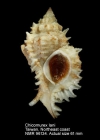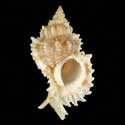WoRMS taxon details
Chicomurex lani Houart, Moe & C. Chen, 2014
746683 (urn:lsid:marinespecies.org:taxname:746683)
accepted
Species
marine
Houart, R.; Moe, C. O.; Chen, C. (2014). <i>Chicomurex lani</i> sp. nov. (Gastropoda: Muricidae), a new species from Taiwan and its intricate history. <em>Bulletin of Malacology, Taiwan.</em> 37: 1-14. [details]
Type locality contained in South China Sea
type locality contained in South China Sea [details]
Distribution Southern Japan, Taiwan, Vanuatu, Coral Sea, New Caledonia, Northeast Australia, southern Great Barrier Reef, Lady Elliot...
Distribution Southern Japan, Taiwan, Vanuatu, Coral Sea, New Caledonia, Northeast Australia, southern Great Barrier Reef, Lady Elliot Is., bathymetric range approximately 40–300 m for living specimens. [details]
MolluscaBase eds. (2024). MolluscaBase. Chicomurex lani Houart, Moe & C. Chen, 2014. Accessed through: World Register of Marine Species at: https://www.marinespecies.org/aphia.php?p=taxdetails&id=746683 on 2024-04-24
Date
action
by
![]() The webpage text is licensed under a Creative Commons Attribution 4.0 License
The webpage text is licensed under a Creative Commons Attribution 4.0 License
original description
Houart, R.; Moe, C. O.; Chen, C. (2014). <i>Chicomurex lani</i> sp. nov. (Gastropoda: Muricidae), a new species from Taiwan and its intricate history. <em>Bulletin of Malacology, Taiwan.</em> 37: 1-14. [details]
additional source Houart, R., Moe, C. & Chen C. (2021). Living species of the genera <i>Chicomurex</i> Arakawa, 1964 and <i>Naquetia</i> Jousseaume, 1880 (Gastropoda: Muricidae) in the Indo-West Pacific. <em>Novapex.</em> 22 (hors-série 14): 1-52.
page(s): 15, figs 4G–H; 11E–M; 12A–D; 18 [details]
additional source Houart, R., Moe, C. & Chen C. (2021). Living species of the genera <i>Chicomurex</i> Arakawa, 1964 and <i>Naquetia</i> Jousseaume, 1880 (Gastropoda: Muricidae) in the Indo-West Pacific. <em>Novapex.</em> 22 (hors-série 14): 1-52.
page(s): 15, figs 4G–H; 11E–M; 12A–D; 18 [details]
 Present
Present  Present in aphia/obis/gbif/idigbio
Present in aphia/obis/gbif/idigbio  Inaccurate
Inaccurate  Introduced: alien
Introduced: alien  Containing type locality
Containing type locality
From editor or global species database
Distribution Southern Japan, Taiwan, Vanuatu, Coral Sea, New Caledonia, Northeast Australia, southern Great Barrier Reef, Lady Elliot Is., bathymetric range approximately 40–300 m for living specimens. [details]

